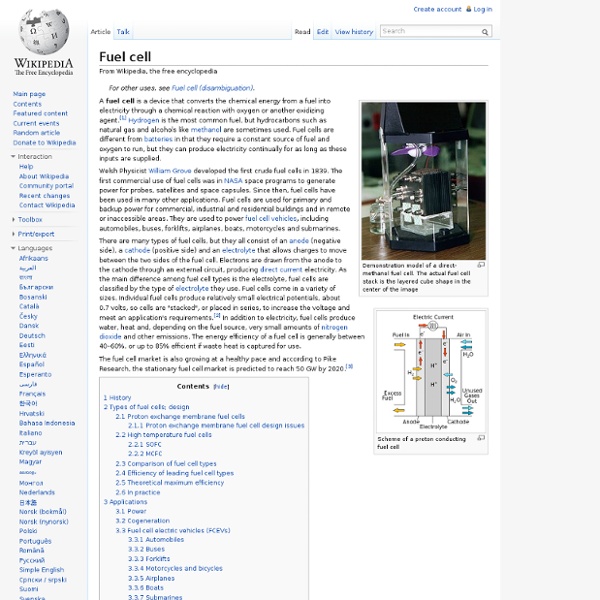Fuel cell

Playing With Time
Aluna: World's First Tidal Powered Moon Clock
牛津通识读本
牛津通识读本 系列 (或 VSI 系列) 是由牛津大学出版社自1995年开始陆续出版的一套 系列丛书 。 这套书的每一本都对一个特定的主题进行简洁而精炼的介绍。几乎所有的读本都是由公认的专家撰写,篇幅为100–150页,并包括进一步深度阅读的建议。作者们往往提供了个人的见解,但每个读本都力图做到中立和完整。 截至2009年4月,该系列丛书已达200多本, 包括 历史, 神学, 文艺理论, 科学哲学, 后现代主义, 情绪, 动物权利, 伦理, 莎士比亚, 休谟, 恐怖主义, 西班牙内战 以及进化论. 出版商表示"该系列丛书将会涵盖所有的主要学科, 为所有读者提供一个可读性强且包罗万千的工具书图书馆。" 牛津通识读本系列上市以来已经取得了极大的成功,[1] 其中许多读本被作为了大学的入门教材。 许多读本明确归列为属于通识读本系列,但也有一些是牛津大学出版社以前出版过的。 读本清单[编辑] 未来出版[编辑] 人物传记苏联写作与手稿共产主义清教徒主义宗教改革时尚汤姆斯-阿奎纳斯圣经考古学沙漠诺曼征服里根革命摩门经宗教哲学 套装[编辑] 2006年牛津大学出版社还出版了六盒套装,每套均为不同的主题。 选举套装政治(008)资本主义(108)民主(075)社会主义(126)法西斯主义(077)大脑套装进化论(100)意识(121)智力(039)宇宙学(051)量子理论 (069)思想套装黑格尔(049)马克思(028)尼采(034)叔本华(062)克尔郭凯尔(058)通识基础套装哲学(055)数学(066)历史(016)政治(008)心理学(006)轰鸣套装古代战争 (117)冷战 (087)十字军(140)法国大革命 (054)西班牙内战 (123)图像套装艺术史 (102)文艺复兴时期艺术 (129)现代艺术 (120)建筑(072)设计(136) 参考文献[编辑] ^ 截至2008年初, 牛津大学出版社该系列丛书在全世界的销量已达200多万册,详见出版商网站 外部链接[编辑] Oxford University Press VSI homepage
格利泽581d
格利澤581d(英語、德語:Gliese 581 d)是一顆系外行星,繞行位於天秤座的紅矮星格利澤581,距離地球約20.5光年。它的質量為地球質量的8倍,被認為是一顆超級地球或迷你海王星。於2007年發現格利澤581d的科學家小組在2009年4月下旬藉由新的觀測結果判斷該行星位於適居帶當中,意味著它可能有液態水或生物存在。 發現[编辑] 瑞士日內瓦天文台的天文學家史帝芬·奧戴利等人(Stéphane Udry)於2007年4月24日使用歐洲南方天文台位於智利拉息拉天文台(La Silla Observatory)3.6公尺望遠鏡的高精度視向速度行星搜索器(High Accuracy Radial Velocity Planet Searcher)發現格利澤581d。 母恆星格利澤581的运动轨迹表明格利澤581d的質量最少是8倍地球質量[3]。 氣候[编辑] 一開始科學家認為格利澤581d的軌道位於理論的適居區之外。 歐洲南方天文台在2009年4月21日宣布發現格利澤581e的消息,並且更精確的測量格利澤581d的軌道,確認它確實位在適居區域當中[11][1] 。 出自地球的訊息[编辑] 另一位藝術家想像中的格利澤581 d是一顆超級地球。 在2008年10月,電腦網路網站Bebo的成員發送出出自地球的訊息,使用隸屬於烏克蘭國家太空機構的RT-70電波望遠鏡,發送了強力的訊息至格利澤581 d。 作為在澳大利亞國家科學周慶祝活動的一部分,宇宙雜誌推出從地球來的問候網站收集郵件,送出訊息至格利澤581 d。 參考資料[编辑] ^ 1.0 1.1 1.2 1.3 1.4 Mayor et al. 外部連結[编辑] Gliese 581 d
Related:
Related:



